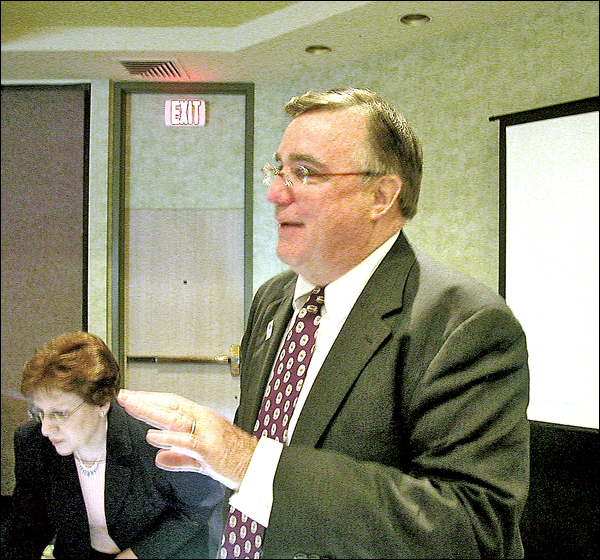As published in the September 1, 2006 issue of Toledo Business Journal


Richard Fleming, president and CEO, St. Louis Regional Chamber and Growth Association
Private sector leaders
spur growth
Regional collaboration instrumental in transforming St. Louis area
Area leaders reviewed elements of a highly successful formula for economic and community development. This formula involved a series of initiatives put in place by private sector leaders in the St. Louis area during the past decade.
Richard Fleming, president and CEO of the St. Louis Regional Chamber and Growth Association (RCGA), traveled to Toledo to speak at an event hosted by the Toledo Area Chamber of Commerce.
Economic development efforts in the Greater St. Louis area provide insight into a Midwestern region that has overcome significant problems and achieved impressive success in transforming its economy and the quality of life for its citizens.
The initiatives undertaken by private sector leaders in the Greater St. Louis area during the past decade provide guidance on how to transform a regional economy.
The St. Louis region’s economy faced extremely difficult challenges in the 1970s and 1980s. Manufacturing declined due to increased global competition, and the economy experienced sluggish growth.
The Greater St. Louis area faced adversity with the loss of major Fortune 500 companies, including Trans World Airlines, McDonnell-Douglas, and Mercantile Bank. The acquisition of St. Louis-based May Department Stores Company by Federated Department Stores, Inc. of Cincinnati is another blow to the area’s economy that private sector leaders are already working to overcome. May Department Stores is the third largest public company in the St. Louis area. At least 3,000 jobs located in downtown St. Louis may be impacted.
The region has been highly successful at transforming its economy beginning in the latter half of the 1990s. Since 1995, the regional economy created more than 107,000 net new jobs, after more than a decade of no net job growth. In the past several years, the Greater St. Louis area emerged from the 2001 economic downturn and generated a rate of net job growth that ranked fourth in the nation.
The region’s economic development successes were accomplished in a very difficult environment, according to Brian Bosworth, a nationally noted economic development consultant. Bosworth visited Toledo recently to discuss the role of private sector leadership in solving difficult community problems. Bosworth explained that the Greater St. Louis area faced an extremely high level of political fragmentation with two states (Missouri and Illinois), 16 counties (8 in Missouri and 8 in Illinois), 93 municipalities, 760 units of local government, and a 50-50 split between Republicans and Democrats.
Private sector leadership has been one of the keys to addressing the difficult economic and community problems facing Greater St. Louis. There are three organizations that represent the business community in the region: the St. Louis Regional Chamber and Growth Association (RCGA), the Regional Business Council (RBC), and Civic Progress. RCGA has approximately 4,000 members. RBC is an organization of leaders of mid-sized corporations in the region that was spun off from the chamber of commerce for the purpose of expanding private sector leadership. Civic Progress is a council of the CEOs from the area’s 30 largest companies.
In an interview with Toledo Business Journal, Fleming advised that the three business leadership groups all share much of the same staff. In addition, the three entities put significant effort into coordinating their plans and agendas.
In 2000, a program called Shaping a Greater St. Louis was initiated to establish a regional agenda that would be supported by a broad base throughout the 16-county area. Eight long-term regional initiatives were established with the goal of positioning the greater St. Louis area as an economic leader in the 21st century. These eight initiatives were designed to bring together government, business, and civic leaders to energize the region and to accomplish job growth.
Fleming discussed this critical program in detail during the interview. Close to 1-1/2 years were spent developing a strategic plan for the region. John Bachman, CEO and managing partner of Edward Jones Investments, led the effort.
One of the eight regional initiatives is a program that is called Forward Metro St. Louis. This program is aimed at addressing issues that impact the region’s ability to be competitive in retaining and attracting businesses and jobs. The program has focused on getting leaders to speak with one voice when addressing major public policy issues.
Three major public policy efforts were undertaken in the Forward Metro St. Louis program. One effort involved the area of education in which the school funding formula for the state was completely transformed. Another effort involved economic development in which state law was changed to provide a 25 percent tax credit for historic restoration partly aimed at restoring downtown areas in the state. A third effort involved transportation which concentrated, in part, on obtaining a new $1.6 billion Mississippi River bridge.
Another of the eight regional strategy initiatives involves the retention, expansion, and recruitment of businesses. The 100-member Greater St. Louis Economic Development Network was established to facilitate these efforts in the 16-county region. The organization is a vehicle for collaborative marketing, business recruitment and retention, and other joint regional projects. This initiative also raised $15 million to support economic development for 2000-2004. A current campaign is being completed that has raised over $20 million for 2005-2009.
Other strategic efforts that were part of the eight regional initiatives included the Private Sector Infrastructure Council, an industry cluster development program, a downtown development program, a minority entrepreneurial development program, and establishment of a program to expand the involvement and support from area businesses in the process of economic development.
Fleming discussed the downtown development program with Toledo Business Journal. “We decided that the future of the downtown was as much the region’s concern as it was the City’s,” explained Fleming.
A program called Downtown Now was launched as part of this initiative. $1.5 million was spent to develop a plan for the downtown’s revitalization. A key element in the revitalization was the area’s success in getting a state law put in place to provide a 25 percent historic tax credit.
Fleming explained that this effort has been extremely successful in transforming the downtown. Over $3 billion of new investment has been made in the downtown area. “Ninety to 95% of this investment has utilized the historic tax credit put in place. Last year we added 500 housing units in the downtown area. This year, there are currently 1,000 housing units under construction,” Fleming explained.
Fleming shared other initiatives undertaken in this effort that have transformed the St. Louis area. Each initiative was part of a plan to enable the region to redefine itself, reinvigorate its economy, and transform the quality of life for its citizens.
A key element in the success of the region’s transformation has been leadership from the private sector. This was the critical element that resulted in development of a regional strategy plan and aggressive implementation of its eight major initiatives.
The decision to take a regional approach and utilize the expanded resources from the surrounding area has also been a key to success. Formation of true partnerships by the private sector leaders with public sector entities around the region has been extremely important.
There is another factor that has been critical to undertaking and accomplishing the significant number of difficult initiatives established by the region’s leadership. Early in the process, private sector leaders made the decision to figure out how to expand the number of businesses and their executives that would get involved in supporting and initiating and leading action plans to accomplish the ambitious goals and objectives. In one effort, the St. Louis Regional Chamber and Growth Association spun off a group of mid-sized companies and organized their CEOs into an entity called the Regional Business Council (RBC) in order to expand the leadership base in the region.
The programs that were put in place to get more private sector individuals involved have been instrumental in significantly raising the level of financial and manpower resources that were needed for each of the eight major strategy initiatives.
The transformation of the economy in the greater St. Louis area has taken place over the past decade in large part as a result of the efforts of private sector leaders who developed and implemented an aggressive regional set of strategic initiatives.
Currently, new efforts by private sector leaders involving the Regional Growth Partnership (RGP) provide significant opportunities to support strategic initiatives for economic development in northwest Ohio and southeast Michigan. While the recent focus has been on raising private funds for the RGP, the most significant benefit will come from increased involvement by private sector leaders in regional economic development.